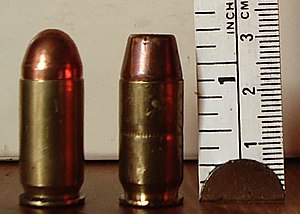.45 ACP
| .45 ACP | |
|---|---|

.45 ACP cartridges full metal jacket (left) and hollow-point (right).
|
|
| Type | Pistol |
| Place of origin | United States of America |
| Service history | |
| Wars | World War I – present |
| Production history | |
| Designer | John Browning |
| Designed | 1905 |
| Variants | .45 ACP +P, .45 Auto Rim, .45 Super |
| Specifications | |
| Case type | Rimless, straight |
| Bullet diameter | .451 in (11.5 mm) |
| Neck diameter | .473 in (12.0 mm) |
| Base diameter | .476 in (12.1 mm) |
| Rim diameter | .480 in (12.2 mm) |
| Rim thickness | .049 in (1.2 mm) |
| Case length | .898 in (22.8 mm) |
| Overall length | 1.275 in (32.4 mm) |
| Case capacity | 25 gr H2O (1.6 cm3) |
| Rifling twist | 1 in 16 in (406 mm) |
| Primer type | Large, Small [pistol]] |
| Maximum pressure (C.U.P.) | 19,000 psi (130 MPa) |
| Maximum pressure (C.U.P.) | 21,000 psi (140 MPa) |
The .45 ACP (Automatic Colt Pistol), or .45 Auto (11.43×23mm) is a handgun cartridge designed by John Browning in 1905, for use in his prototype Colt semi-automatic pistol. After successful military trials it was adopted along with the Browning .45 Colt handgun as the .45 M1911 cartridge. The handgun was designated M1911 handgun.
The U.S. Cavalry had been buying and testing various handguns in the late 1890s and early 20th century. The .45 Colt Single Action Army (SAA) had largely been replaced, even by some double-action versions of the same. The Army had fielded some double-action revolvers in .38 Long Colt. They determined the .38 caliber round was significantly less effective than the .45 Colt against determined opponents such as the Moro juramentado warriors encountered in the Moro Rebellion. The then-current issue rifle, the .30-40 Krag, had also failed to stop Moro warriors effectively; the British had similar issues switching to the .303 British, which resulted in the development of the dum-dum bullet. This experience, and the Thompson–LaGarde Tests of 1904 led the Army and the Cavalry, to decide a minimum of .45 caliber was required in the new handgun. Thompson and Major Louis Anatole La Garde of the Medical Corps arranged tests on cadavers and animal remains in the Chicago stockyards, resulting in the finding that .45 was the most effective pistol cartridge. They noted, however, training was critical to make sure a soldier could score a hit in a vulnerable part of the body.
...
Wikipedia
